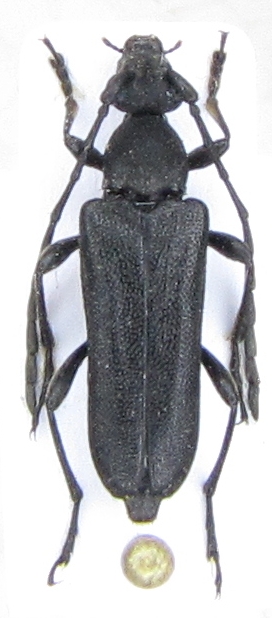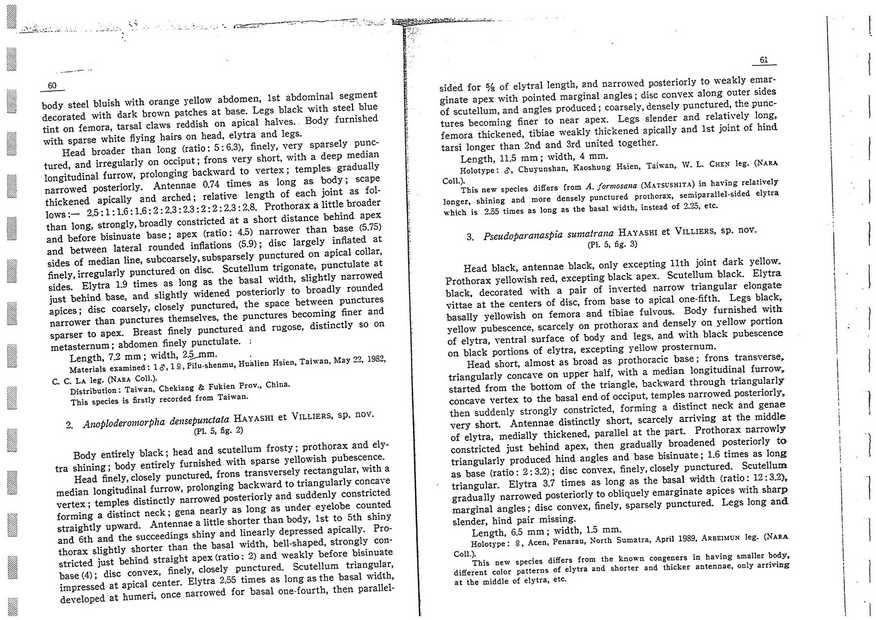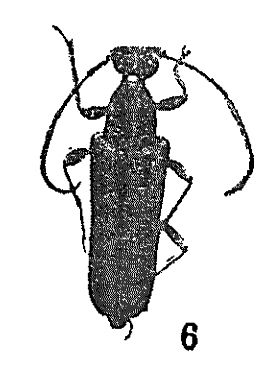| Author |
 Topic Topic  |
|
|
Vitali
Member Rosalia
  
Estonia
993 Posts |
 Posted - 11/01/2012 : 09:13:17 Posted - 11/01/2012 : 09:13:17



|

To add to the topic of Anoploderomorpha.
The photo is not of a good quality, but maybe anyone can at least confirm that the beetle belongs to this genus.
It comes from Taiwan.
Three species were recorded from Taiwan: A. densepunctata Hayashi & Villiers, 1994, A. formosana (Matsushita, 1933) and A. izumii Mitono & Tamanuki, 1939.
I understand that identifying black Anoploderomorpha by photo is almost impossible, but maybe one can exclude any of the listed three species by some character, for example, by colour? |
Edited by - Xavier on 27/01/2016 00:35:33 |
|
|
horshehden
Member Purpuricenus
 
Czech Republic
424 Posts |
 Posted - 11/01/2012 : 10:32:58 Posted - 11/01/2012 : 10:32:58



|
A. (A) izumii is different by colour.
It looks more like A. (A) formosana than densepunctata, but I need my collection in hand to confirm it. |
 |
|
|
Vitali
Member Rosalia
  
Estonia
993 Posts |
 Posted - 11/01/2012 : 13:33:24 Posted - 11/01/2012 : 13:33:24



|
| Thank you. If the photo is insufficient, could you please indicate some feature to distinguish between A. formosana and A. densepunctata? |
 |
|
|
horshehden
Member Purpuricenus
 
Czech Republic
424 Posts |
 Posted - 11/01/2012 : 13:44:32 Posted - 11/01/2012 : 13:44:32



|
Insufficient is my time schedule:-)
will try to answer on Sun. |
 |
|
|
horshehden
Member Purpuricenus
 
Czech Republic
424 Posts |
 Posted - 17/01/2012 : 14:15:40 Posted - 17/01/2012 : 14:15:40



|
| If this description will not correspond to your specimen, it will be A. formosana. |
 |
|
|
horshehden
Member Purpuricenus
 
Czech Republic
424 Posts |
 Posted - 17/01/2012 : 14:20:41 Posted - 17/01/2012 : 14:20:41



|

...and attachement. |
 |
|
|
Vitali
Member Rosalia
  
Estonia
993 Posts |
 Posted - 17/01/2012 : 14:34:51 Posted - 17/01/2012 : 14:34:51



|
| Probably the attachment name contained a space. I seem to have seen a corresponding warning placed once by Francesco. |
 |
|
|
horshehden
Member Purpuricenus
 
Czech Republic
424 Posts |
 Posted - 17/01/2012 : 15:15:38 Posted - 17/01/2012 : 15:15:38



|

so may be now.. |
 |
|
|
Vitali
Member Rosalia
  
Estonia
993 Posts |
 Posted - 17/01/2012 : 15:17:42 Posted - 17/01/2012 : 15:17:42



|
| Yes, thank you! I'll let you know the result later. |
 |
|
|
Francesco
Forum Admin
    
Luxembourg
9454 Posts |
 Posted - 18/01/2012 : 22:25:05 Posted - 18/01/2012 : 22:25:05




|
| mmmhm... the species was described on the basis of only one male (here we have a female), it is different in puncturing (not guessable here)... difficult! |
 |
|
|
horshehden
Member Purpuricenus
 
Czech Republic
424 Posts |
 Posted - 18/01/2012 : 22:29:50 Posted - 18/01/2012 : 22:29:50



|
According to the Taiwanese book, A. densepunctata should be restricted to southernmost Taiwan.
What is the locality here? |
 |
|
|
Vitali
Member Rosalia
  
Estonia
993 Posts |
 Posted - 20/01/2012 : 21:41:01 Posted - 20/01/2012 : 21:41:01



|
Sorry for late reply, I was away from home.
Thank you for the description and comments.
I have a pair of these beetles. The male is slender and with a bit longer antennae. The puncture of pronotum is extremely dense, the intervals between points form thin ridges, which are slightly shiny. However, by no way I would call the whole pronotum shiny. Its appearance is rather obscure because of such a dense punctuation. Elytra are really shiny, their punctures are dense but not that much as in pronotum. Generally, regarding the density of punctures, the beetles could be regarded A. densepunctata. The length/width ratio of elytra is between 2.46 and 2.56, slightly depending on measuring angles. This also fits this species.
However, it comes from Puli, Nantou, that is from Northern Taiwan, which is not suitable for A. densepunctata.
Finally, what makes me doubt, is a strong depression in the basal part of elytra in both sexes, which is not mentioned in the description of A. densepunctata. Such a prominent feature cannot be overlooked. The depression is oblique from shoulders towards the centre behind scutellum. Because of it, a sharp flying-bird-like ridge is formed along the elytra base, curved around scutellum. It can be seen even in the bad photo I placed first.
So, what will be the decision? :-) |
 |
|
|
Francesco
Forum Admin
    
Luxembourg
9454 Posts |
 Posted - 20/01/2012 : 22:03:09 Posted - 20/01/2012 : 22:03:09




|

According to me, your description and the locality fit well with Anoplodera formosana, whose original description can be read at the page 198 here.
At the left the holotype (a male according to Matsushita, but it seems to be a female). |
 |
|
|
Vitali
Member Rosalia
  
Estonia
993 Posts |
 Posted - 20/01/2012 : 23:15:26 Posted - 20/01/2012 : 23:15:26



|
Thank you a lot! Well, now having both descriptions on hand I find the description of A. formosana (too laconic though) fitting better my beetle.
The proportions of elytra still remain a puzzle, but other features seem correct. |
 |
|
|
Francesco
Forum Admin
    
Luxembourg
9454 Posts |
 Posted - 21/01/2012 : 07:35:52 Posted - 21/01/2012 : 07:35:52




|
As you noticed, the length/width ratio slightly depends on measuring angles... and Villiers measured only one specimen.
It would be interesting to know the real variability of that proportions. |
 |
|
| |
 Topic Topic  |
|


